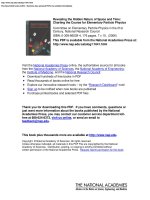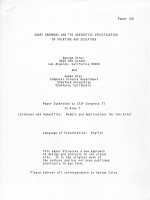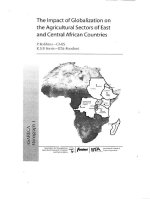- Trang chủ >>
- Khoa Học Tự Nhiên >>
- Vật lý
The Quantum Mechanics of Minds and Worlds
Bạn đang xem bản rút gọn của tài liệu. Xem và tải ngay bản đầy đủ của tài liệu tại đây (10.61 MB, 284 trang )
The Quantum Mechanics
of Minds and Worlds
JEFFREY ALAN BARRETT
OXFORD
UNIVERSITY PRESS
www.pdfgrip.com
www.pdfgrip.com
THE QUANTUM MECHANICS OF
MINDS AND WORLDS
www.pdfgrip.com
TItis book has been printed digitally and produced in a standard specification
in order to ensure its continuing availability
OXFORD
UNIVERSITY PRESS
Great Clarendon Street, Oxford OX2 6DP
Oxford University Press is a department of the University of Oxford.
It furthers the University's objective of excellence in research, scholarship,
and education by publishing worldwide in
Oxford New York
Auckland Bangkok Buenos Aires Cape Town Chennai
Dar es Salaam Delhi Hong Kong Istanbul Karachi Kolkata
Kuala Lumpur Madrid Melbourne Mexico City Mumbai Nairobi
Sao Paulo Shanghai Taipei Tokyo Toronto
Oxford is a registered trade mark of Oxford University Press
in the UK and in certain other countries
Published in the United States
by Oxford University Press Inc., New York
© Jeffrey A. Barrett 1999
The moral rights of the author have been asserted
Database right Oxford University Press (maker)
Reprinted 2003
All rights reserved. No part of this publication may be reproduced,
stored in a retrieval system, or transmitted, in any form or by any means,
without the prior permission in writing of Oxford University Press,
or as expressly permitted by law, or under terms agreed with the appropriate
reprographics rights organization. Enquiries concerning reproduction
outside the scope of the above should be sent to the Rights Department,
Oxford University Press, at the address above
You must not circulate this book in any other binding or cover
and you must impose this same condition on any acquirer
ISBN 0-19-924743-9
www.pdfgrip.com
For Martha, Thomas, and Jacob
www.pdfgrip.com
www.pdfgrip.com
Alexander wept when he heard from Anaxarchus that there
was an infinite number of worlds; and his friends asking him
if any accident had befallen him, he returns this answer: 'Do
you not think it a matter of lamentation that when there is
such a vast multitude of them, we have not yet conquered
one?'
(Plutarch, On the Tranquillity ofMind)
www.pdfgrip.com
www.pdfgrip.com
PREFACE
T HIS book is about the quantum measurement problem, Hugh Everett
Ill's proposed resolution, and some of the attempts to understand how it
was supposed to work. While there is a brief review of the standard formulation of quantum mechanics (complete with a description of a two-slit
experiment!) and a short appendix describing the Hilbert-space formalism, it is assumed that the reader already knows something about how
quantum mechanics works and is comfortable with at least some of the
mathematics. There is, in my opinion, no better introduction to the ways of
quantum mechanics than David Albert's book Quantum Mechanics and
Experience. One might also want to work through a careful presentation
of the theory that includes a more detailed description of the mathematical formalism. P. A. M. Dirac's Principles of Quantum Mechanics is
the classic introductory text (and I use Dirac's notation throughout this
book). My favourite advanced introduction is Gordon Baym's Lectures on
Quantum Mechanics. John Wheeler and W. H. Zurek's Quantum Theory
and Measurement is the standard anthology on the measurement problem.
I have tried to refer to page numbers in this anthology whenever possible.
Many conversations with friends and colleagues contributed to this
book; in particular, I should like to thank Wayne Aitken, Frank Arntzenius,
Guido Bacciagallupi, Jeffrey Bub, Rob Clifton, Michael Dickson, Richard
Healey, Meir Hemmo, Peter Lewis, Barry Loewer, Pen Maddy, Brad
Monton, Laura Reutsche, Simon Saunders, and Brian Skyrms. I am especially indebted to David Albert for many enlightening discussions over the
past several years-anyone familiar with Albert's work will immediately
recognize his influence on the way that I think about quantum mechanics.
I should also like to thank the anonymous referees who read this book in
manuscript form-their comments were invaluable in putting together the
final version. Finally, I should like to thank Ryan Barrett, whose excellent
work produced the final figures. It was a pleasure working with the Oxford
University Press editors-they were careful, smart, and patient.
This book was supported by a University of California President's
Research Fellowship, and most of it was written while I was a Visiting Fellow at the University of Pittsburgh Center for the History and Philosophy of Science in 1996-7. I should like to thank both universities for
their kind support.
J. A. B.
www.pdfgrip.com
www.pdfgrip.com
CONTENTS
List offigures
xiv
1 A brief introduction
1.1
1.2
A textbook example: The two-slit interference experiment
Another textbook example: Spin properties of spin-! systems
1
2
8
1.3
A more exotic example: The curious behaviour of neutral
K mesons
The measurement problem
11
14
1.4
2
The standard formulation of quantum mechanics
2.4
2.5
How the theory works
Two discontents
18
18
22
30
31
37
38
41
2.6
Von Neumann's psychophysical parallelism and
Wigner's friend
The measurement problem (again)
47
54
2.1
2.2
2.3
The foundations of a new theory
The collapse of the wave function
Von Neumann's formulation of quantum mechanics
2.3.1
2.3.2
2.7
The standard theory
A summary of the theory
3 The theory of the universal wave function
3.1
3.2
3.3
3.4
3.5
3.6
3.7
3.8
3.9
4
What's wrong with von Neumann's theory?
Other formulations ofquantum mechanics and their problems
Everett's project
The fundamental relativity of states
The appearance of phenomena
The deduction of subjective appearances
The mechanics of macroscopic systems
What are branches?
Interpreting Everett
The bare theory and determinate experience
4.1
4.2
4.3
4.4
The bare theory
The suggestive properties
Imperfect measurements
The account of experience
www.pdfgrip.com
56
56
59
63
66
70
75
83
86
90
92
94
95
107
110
Contents
Xll
4.5
Problems with the bare theory
Preferred basis
4.5.2 Empirical incoherence
4.5.3 No account of statistical results
4.5.1
4.5.4
5
Selecting a branch
Bohm's theory without the trajectories
Bohm's theory
Surreal trajectories and the persistance of memory
The failure of covariance
Position as the preferred physical property
5.1
5.2
5.3
5.4
5.5
5.6
6
No general account of determinate results
The limiting properties in the context of Bohm's theory
Many worlds
The splitting-world interpretation
Traditional and real problems
6.2.1 Too many worlds?
6.2.2 The feeling of splitting
6.2.3 Compatibility with other physical theories
6.2.4 What it takes to be a world
6.2.5 Identifying worlds
6.2.6 Whence probability?
6.2.7 The preferred-basis problem
6.1
6.2
6.3
7
Many minds
7.1 How many minds?
7.1.1 The single-mind theory
7.1.2 The many-minds theory
7.2 The auxillary dynamics
7.2.1 The transcendental approach
7.2.2 The Bohm-Bell-Vink dynamics
7.3 Lockwood's minds
7.4 Relative facts
7.5
8
Many worlds without splitting
Correlations without correlata
Many histories
Interference effects and the environment
8.1
8.2
The sense in which it is difficult to distinguish pure states
from mixtures
www.pdfgrip.com
114
114
116
117
119
121
122
127
132
140
144
146
149
149
154
154
158
159
160
162
163
173
179
185
185
186
192
197
198
202
206
211
217
221
222
224
Contents
8.3
8.4
8.5
8.6
9
Decoherence and determinate perceptions
Gell-Mann and Hartle's many-histories approach
Some problems
Does the environment select the right determinate quantity?
The determinate-experience problem
xiii
227
232
237
242
245
Appendices
A The Hilbert-space formalism
B A concrete example of an EPR experiment in the
context of the Bare theory
249
249
References
255
Index
263
www.pdfgrip.com
252
LIST OF FIGURES
Two-slit setup.
A open and B open. (a) The A distribution. (b) The B
distribution.
1.3
What should happen and what does happen. (a) The A- or
B- distribution. (b) The interference distribution.
1.4
Two-path setup.
Probability of observing iO at t if the particle is iO at to.
1.5
2.1
Einstein's Solvay experiment.
The x-spin setup.
2.2
2.3
EPR setup.
2.4
Wigner's-friend setup.
A relatively tame Eiffel-Tower trajectory on Bell's
5.1
Everett (?) theory.
5.2
How the probability current moves a single particle.
5.3(a) A simple recording in Bohm's theory. M's wave packet
moves to down if and only if P travels the -} x -path.
5.3(b) The two-particle configuration in a two-particle wave
packet.
Crossing-paths setup.
5.4
Crossing paths with position record.
5.5
The same in configuration space. (a) First half of the
5.6
experiment. (b) Second half of the experiment.
We try to record P's position in M's x-spin.
5.7
The same in configuration space.
5.8
An EPR experiment in Bohm's theory.
5.9
Two EPR experiments in configuration space. (a) A meas5.10
ures first. (b) B measures first.
A difference between Bohm's theory and the bare theory.
5.11
Global states and local states.
6.1
How a connection rule might thread possible local states
6.2
into worlds.
6.3(a) A repeated x-spin measurement in a splitting-worlds
theory.
1.1
3
1.2
www.pdfgrip.com
4
4
10
13
23
29
42
52
125
129
131
132
133
135
136
137
139
141
142
146
153
180
181
List offigures
6.3(b) A repeated x-spin measurement in a many-threads theory.
7.1
A randomly jumping mind.
7.2
Talking to mindless hulks.
A mental dynamics without mindless hulks.
7.3
How
environmental correlations destroy simple interfer8.1
ence effects. (a) The interference distribution. (b) With a
wire loop at A.
www.pdfgrip.com
xv
182
188
190
191
223
www.pdfgrip.com
1
A BRIEF INTRODUCTION
THE standard theory of quantum mechanics, as formulated by P. A. M.
Dirac and John von Neumann, is in one sense the most successful physical
theory ever-no other theory has ever made such accurate empirical predictions. It is all the more impressive because what it successfully predicts,
the behaviour of the basic constituents of all physical things (electrons,
protons, neutrons, photons, etc.), is often wildly counter-intuitive. There
is, however, a problem. If one tries to understand the standard formulation
of quantum mechanics as providing a complete and accurate framework
for the description of all physical interactions, then it soon becomes evident that the theory is at least ambiguous, and, on a less charitable reading,
one might even conclude that it is logically inconsistent. This is known
as the quantum measurement problem. Hugh Everett Ill's formulation
of quantum mechanics and the various reconstructions of his theory that
have appeared since are all attempts to solve the measurement problem.
But before considering possible solutions to the measurement problem,
it is important to be clear about exactly what the problem is.
The basic constituents of matter, when left to themselves, behave in
a way that is apparently nothing like the behaviour of the middle-sized
objects (chairs, coins, cars, cats, etc.) that form the bulk of our experience
and the basis for our physical intuitions. Because their behaviour is so
counter-intuitive, any empirically adequate theory, any theory that makes
the right empirical predictions for the experiments that we have performed
so far, is bound to be itself counter-intuitive. The standard theory of quantum mechanics is certainly counter-intuitive. But that is not the problem.
Rather, the problem is that the standard theory cannot be taken to provide
a complete and accurate physical description of the odd behaviour that it
is supposed to describe.
Our most careful observations suggest that the basic constituents of
matter behave in a fundamentally random way. They also suggest that
the basic constituents of matter sometimes behave like particles and
sometimes like waves. The particle-like behaviour of fundamental particles is seen in such phenomena as cloud-chamber tracks and marks
www.pdfgrip.com
A briefintroduction
2
on photographic film. This particle-like behaviour agrees well with the
physical intuitions we have developed from our experience with middlesized physical systems. The wave-like behaviour offundamental particles
(and of other simple, well-isolated physical systems) is seen in interference phenomena. This wave-like behaviour of matter is very different
from what one would expect from middle-sized physical systems-one
might, for example, expect a particle (or any other physical object) to
have a determinate position and to follow a determinate trajectory, not to
spread out like a wave on a pond.
While one might lament the loss of classical determinism, it is the dual
behaviour of matter that is really puzzling. Particles (and other simple,
well-isolated systems) seem to behave one way when no one is looking (the odd quantum wave-like way) and another way when someone is.
This dual behaviour is represented in the standard formulation of quantum
mechanics by two dynamical laws: one law describes the evolution of a
physical system when no one is looking and the other describes the evolution of the system when someone does. These two dynamical laws and the
criterion for when each obtains is the ultimate source of the measurement
problem in the standard theory.
There are two stock examples of quantum interference effects that we
will return to in various forms throughout the book. One ofthese is the twoslit experiment and the other is Wigner's Stem-Gerlach experiment. Both
are discussed below, followed by a somewhat more exotic example. Each
experiment shows the sort of quantum weirdness that any satisfactory
formulation of quantum mechanics must ultimately predict and explain.
1.1
A textbook example: The two-slit inteiference experiment
In the standard two-slit experiment one imagines launching particles, one
at a time, at a barrier with two slits cut in it and with a screen beyond the
slits (Fig. 1.1). This sort of experiment works with fundamental particles
like electrons, but similar experiments have been performed with larger,
more complicated systems. Indeed, atoms, molecules, superconducting
rings, and other physical systems exhibit similar interference effects in the
context of other experiments. Most of the particles just crash into the
barrier, but some pass through the slits and strike the screen. It is the pattern
of the particle distribution on the screen that suggests that the particles
behave like waves while they are travelling towards the screen and no one
is looking.
www.pdfgrip.com
A briefintroduction
3
(
eO source
Barrier
Phosphorescent screen
FIG. 1.1 Two-slit setup.
First, consider what happens if we force each particle to pass one at
a time through either one slit or the other. Suppose we close the lower
slit B so that each particle must pass through the upper slit A. In this case,
unsurprisingly, we get a particle distribution on the screen that is perfectly
consistent with each particle having passed through A (one determines the
particle distribution by choosing a convenient partition of the screen, then
counting the number of particles that hit in each cell of the partition). Call
this the A distribution. Ifwe close A and send one particle at a time towards
the barrier, we get a particle distribution that is perfectly compatible with
each particle passing through B. Call this the B distribution.
So if we open both slits and send each particle one at a time towards the
barrier, then if each particle passes through either A or B, one would expect
to get a particle distribution that is a weighted sum of the A distribution
(Fig. 1.2a) and the B distribution (Fig. 1.2b). If we aim the particles at a
point halfway between the two slits (as well as we can aim them), then one
would expect that about as many particles would pass through A as would
pass through B, so one would expect to get a distribution like Figure l.3a.
Call this the A-or-B distribution-this is the distribution one would expect
to get with a symmetric source if each particle either determinately passed
through A or determinately passed through B.
We can check to make sure that the A -or- B distribution is what we do in
fact get when each particle determinately goes through A or determinately
www.pdfgrip.com
A briefintroduction
4
Barrier
The A distribution
Screen
Barrier
Screen
The B distribution
(a)
(b)
FIG. 1.2 A open and B open. (a) The A distribution. (b) The B distribution.
A
B
~
~
~
Barrier
Screen
The A or B distribution
Barrier
Screen
The interference distribution
(a)
(b)
FIG. 1.3 What should happen and what does happen. (a) The A- or B- distribution.
(b) The interference distribution.
www.pdfgrip.com
A brief introduction
5
goes through B by sending the particles one at a time toward the barrier
and then closing one or the other of the two slits at random for each trial.
When we do this, we get precisely the A -or- B distribution that one would
expect (Fig. 1.3a). Consequently, one might naturally expect that if we
do not move the source but open both A and B at the same time, then
we will again get the A -or- B distribution. Indeed, one might be tempted
to claim that with a symmetric source each particle determinately passes
through one or the other of the two slits if and only if one gets the A-or-B
distribution.
So what distribution do we get when both slits are open at the same
time? We get one like Figure 1.3b. Call this the interference distribution,
and note that it is nothing like the A -or- B distribution. The immediate
consequence is that if one takes the A-or-B distribution to be characteristic of each particle either determinately passing through A or determinately passing through B, then one must conclude on the basis of what
we actually see when we perform such experiments that at least some
particles did not determinately pass through either slit! These particles
did, however, somehow manage to get to the screen. So how did they get
to the screen without determinately passing through A or determinately
passing through B? What sort of trajectories could they have followed?
According to the standard von Neumann-Dirac formulation ofquantum
mechanics (which we will consider in some detail in the next chapter) the
particles do not determinate1y pass through one slit or the other when both
A and B are open; rather, the theory tells us that each particle follows a
superposition of different trajectories and thus ends up in a superposition
of passing through A and passing through B. A particle in a superposition
of passing through each slit does not determinately pass through A, does
not determinately pass through B, does not determinately pass through A
and determinately pass through B, and does not determinately not pass
through A and determinately not pass through B. Indeed, a particle that
is in a superposition of passing through A and B has observable physical
properties that differ from each of these four classical alternatives. It is
the fact of each particle's following a superposition of trajectories rather
than determinately passing through one slit or the other that explains the
interference distribution.
While a particle is moving toward the screen, one might think of it
as a wave, and just as it would be a mistake to ask for the single precise position of a wave, the standard theory tells us that the particle
typically fails to have a determinate position. Part of the wave passes
through A and part passes through B. These two wave packets spread
www.pdfgrip.com
6
A briefintroduction
out and interfere with each other in the region between the barrier and
the screen, and then the composite wave strikes the screen. At approximately this point in the story, and one cannot say exactly when or how
this occurs, the particle stops acting like a wave-when we look at the
screen we do not see the global effects one would expect from a spread-out
wave striking the surface of the screen but rather we see the effects one
would expect from a single particle striking a single determinate point.
On the other hand, the wave-like behaviour of each particle individually
is seen in the overall particle distribution when the basic experiment is
repeated many times. One might naturally conclude from such repeated
experiments that the wave associated with each particle determines the
probability of that particle being found in each region of the screen, and
this is precisely what the standard theory predicts (and, to some extent,
explains).
The state of a physical system is represented by a vector in quantum
mechanics (something I shall discuss in more detail in the next chapter and
Appendix A). If we represent the state where a particle P determinately
passes through A by the vector IA) p and the state where it determinately
passes through B by the vector IB) p, then a state where P is in a superposition of passing through each slit might be represented by a linear
combination (or sum) of these two vectors alA) p + !JIB) p, where a and
!J are complex-valued coefficients. When one is interested in the position of a particle, the vectors one uses to represent the particle's state are
functions that assign a complex number to each possible position. The
wave function 1fr that represents the state of a particle may be spread out
or well-localized. If it is spread out, then the particle is far from having
a determinate position. The better localized the wave function, the closer
the particle is to having a fully determinate position.
The puzzle is that, regardless of a particle's initial state, whenever
one looks for it (that is, whenever one makes a position measurement),
one always finds it with a determinate position. The von Neumann-Dirac
formulation of quantum mechanics explains this by stipulating that whenever one looks for a particle, that particle's state instantaneously and randomly collapses to a state where the particle has a determinate position
(is in an eigenstate of position); that is, the particle's initially spread-out
wave function instantaneously and randomly evolves to a wave function that is localized to the region where one found the particle (more
generally, the particle's state randomly evolves to a state where whatever
physical property one is observing has a determinate property-it evolves
to an eigenstate of the observed property). Which determinate position
www.pdfgrip.com
A briefintroduction
7
the particle acquires is given by probabilities detennined by the wave
function that represented the particle's state just before it was observed.
More specifically, the standard theory predicts that if 1fr represents the
complex-valued wave associated with a particular particle, then the probability of finding that particle in a region R is equal to the sum (or, more
precisely, the integral) of 11fr 12 over R.
Before we look at the screen, the standard theory tells us that there is
no detenninate matter of fact concerning where the particle is. According
to the standard interpretation of states (given in the standard theory by the
eigenvalue-eigenstate link), l it is not that the particle has a detenninate
position and that we do not know what it is; rather, it is that it simply fails
to have any detenninate position at all before it is observed. If each particle
had a determinate but unknown position, then one would presumably get
the A -or- B distribution whenever both slits were open, since each particle
would in fact detenninately pass through one slit or the other; but since
we do not get the A-or-B distribution, this was taken as evidence that the
particles do not pass through detenninate slits, which is precisely what the
standard theory tells us. The probabilities predicted by the standard theory,
then, are not a matter of our ignorance-rather, being in a superposition
of different states is observationally distinguishable from detenninately
being in one or the other of the states. In particular, a system in a superposition of states exhibits interference effects not exhibited by a system
determinately in one of the elements of the superposition. But while each
particle in the two-slit experiment fails to have a detenninate position just
before it strikes the screen, the standard theory tells us that the process
of observing the particle somehow endows it with a detenninate position.
Further, the standard theory tells us that if one looks to see which slit
each particle passes through, then one will cause the wave function associated with each particle to collapse to an eigenstate of passing through
one or the other of the two slits (a state where the particle either detenninately passes through A or detenninately passes through B). And, sure
enough, whenever we look to see which slit each particle passes through,
the interference effects are destroyed and we get the A-or-B distribution.
A proponent of the standard collapse theory would take this as (further)
evidence for supposing that the usual wave dynamics is suspended and
the state of a system randomly collapses to an eigenstate of the observable
1 The eigenvalue--eigenstate link says that a system has a particular physical property
if and only if its state is represented by an eigenvector of the operator representing the
property.
www.pdfgrip.com
8
A briefintroduction
one measures whenever a measurement is made (and I shall discuss all
this in more detail in the next chapter).
It is interesting to consider what one would have to do in order to
account for what we see if one insists, contrary to the standard theory, that
each particle does in fact determinately pass through A or determinately
pass through B in the two-slit experiment above. Since the behaviour
of a particle passing through A depends on whether B is open at the
instant the particle passes the barrier (since whether B is or is not open
determines whether the particle passing through A will behave according
to the A-or-B statistics or the interference statistics, and the other way
round), the particle would have to have some way of learning whether
B was open when it passed through A. That is, in order to say that each
particle determinately passes through one or the other of the two slits, one
would somehow have to explain how the state of the slit that it did not
pass through, whether it was open or closed, affects the particle's motion
even when there are no other particles around to carry the information
about the state of that slit-remember: all this happens when we send the
particles through the apparatus one at a time.
One strategy would be to postulate the existence of a new type of
field that affects the motion of each particle in a way that depends on
the state of the slit that the particle did not pass through. If there were
such a field, then one could say that each particle determinately passed
through one slit or the other and then account for the fact that a particle's
behaviour typically depends on the state of the slit that they did not pass
through by appealing to differences in the field. While all this is flatly
inconsistent with the standard formulation of quantum mechanics, this is
essentially how David Bohm's hidden-variable formulation of quantum
mechanics works. I shall discuss Bohm's theory in more detail later. The
point of mentioning it here is just to illustrate the sort of story one would
have to tell in order to explain interference effects if one insisted, in
accord with our intuitions but contrary to the standard theory, that each
particle determinately passes through one slit or the other in the two-slit
experiment above.
1.2
Another textbook example: Spin properties ofspin-f systems
Particles can be in superpositions of being located at different positions,
but they can also be in superpositions of having other incompatible
properties. A particle can, for example, be in a superposition of having different momenta, energies, or different spin properties. The spin
www.pdfgrip.com









